Washing machine machine does not work water intake. Washing machines with a water tank - an overview
The problem of connecting this household unit is faced by those who do not live in a suburban area permanently, but only in the summer season. And then, if there is no central water main or an autonomous system, and water is taken from a well. With a competent approach to solving this issue, there will be no special difficulties with the operation of the washing machine.
general information
To determine the most acceptable way of providing the washing machine with water, you need to understand at least a little about the principle of functioning of these household appliances of the "automatic" class. Depending on the model, they differ in the programs "embedded" in the electronic part, but the specifics of their work are identical.
The figure clearly shows the device of the washing unit.
It is not difficult to trace the path of water passing through an automatic machine: compartment into which the detergent is loaded - tank with drum - drain system(via the corresponding connection). The nuance is that for the correct functioning of the machine (strictly according to the program), it is necessary to provide the required pressure. If this condition is not met, the liquid will be underfilled, and the device malfunctions are guaranteed, since the electronics instantly reacts to the slightest changes in the system parameters.
How to organize water intake
It is advisable to consider all the options practiced in suburban areas, and which of them is preferable, the summer resident, in accordance with the local specifics and his capabilities, will decide on his own.
Method 1 - loading water manually
This technique involves pouring it at the beginning of the passage channel, into the compartment with household chemicals.
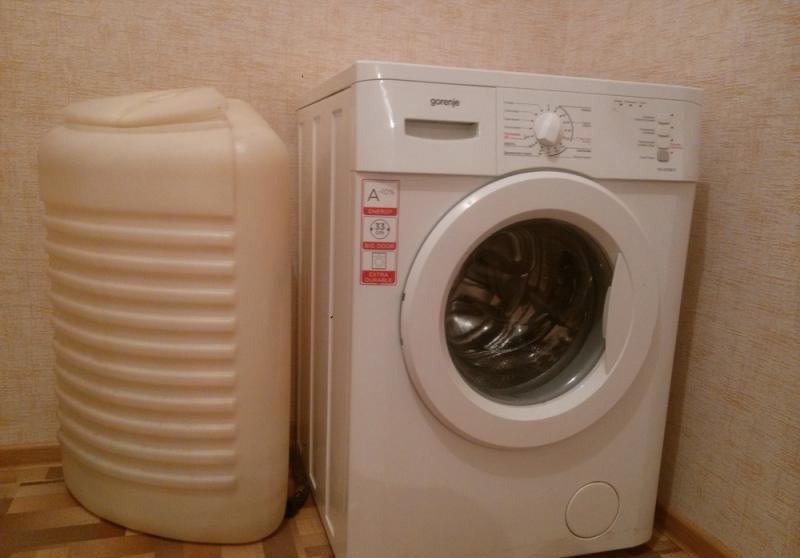
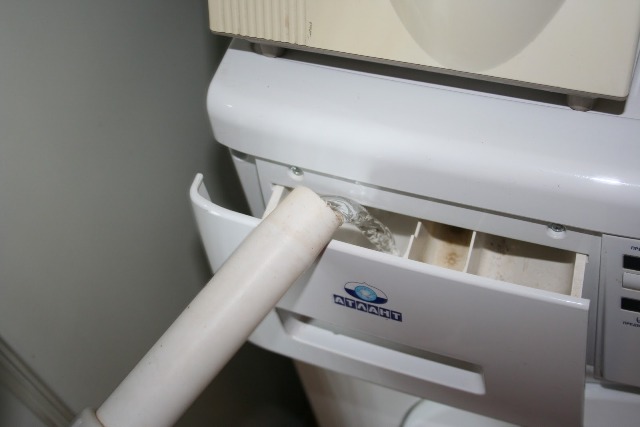
A plus - this option of providing the automatic machine with water does not require additional financial costs.
Minus - the process is quite laborious, and the washing will take a long time. After completing each of the stages provided by the program, you will have to add another portion of water to the automatic machine, as it will stop.
Method 2 - using capacity
To create at least a small pressure in the system, a water tank is installed above the location of the automatic machine.
A plus
Buying a plastic tank is inexpensive. A barrel of 100 liters costs about 1150 - 1250 rubles.
Minuses
- To ensure an acceptable pressure, the difference in height between the washing machine and the tank should be at least 5 - 6 m. Basically, country houses are one-story buildings. Where to install the tank? It is unlikely that anyone will mount it at the level of the ridge or build a special mini-tower with a platform on the site for it.
- Another problem is how to regularly replenish the water supply in the tank? Even if the house is 2 floors, then carrying it upstairs in buckets is an unattractive prospect.
Method 3 - water injection by a pumping station
For example, directly from a well.
A plus
For stable operation of the automatic machine - one of the best options.
Minus
The pumping station is purchased when arranging an autonomous system. This means that in this case there is a water supply system in the country as such. And spending money on the installation just to use it during washing, given the cost of the pumping station, is not the most rational decision. It is unlikely that any of the summer residents will do this.
Method 4 - using a pump
Here, consideration of the advantages and disadvantages of such a technique is meaningless. For a summer cottage where there is no water supply system - the best option. The cost of the pump is low, and even the simplest model will provide constant pumping of water from the tank (well) to washing machine, and its acceptable head for the operation of the device.
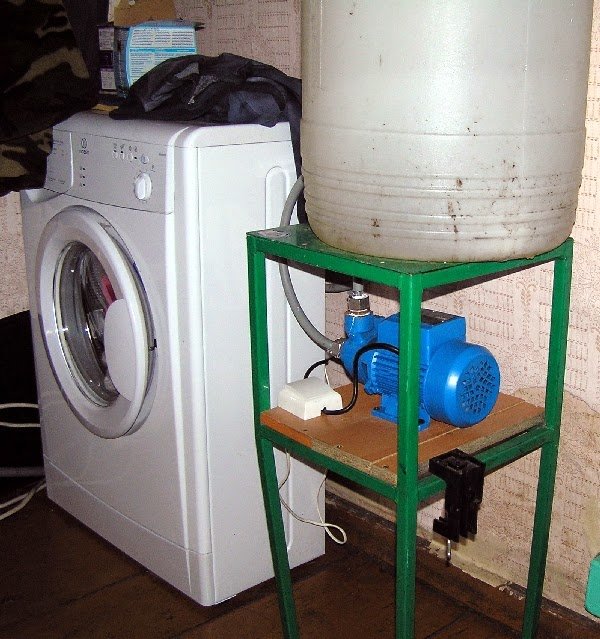
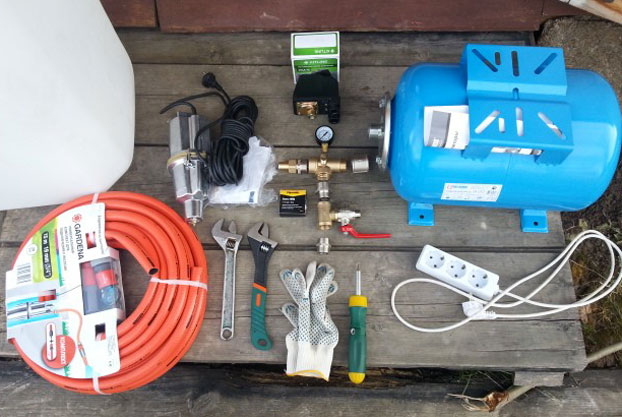
With all the advantages of such an engineering solution, there is also complexity. It consists in the selection of circuit elements by parameters.
For example, the cross-section of the hose (pipe) must be correlated with the pump capacity. This is the only way to achieve the water pressure required for the smooth operation of the washing machine in automatic mode. Difficulties will arise during the acquisition of a pumping device. The variety of equipment models is such that it is difficult for a non-specialist to understand what kind of product it is advisable to buy to solve such a specific problem - providing water to a washing machine.
What is needed additionally
- Container for water. Its recommended minimum capacity is determined based on a ratio of 50 liters per 1 complete cycle. And with a specific volume, you will have to decide, taking into account the possibilities for installing the tank in a place chosen in the country.
- Relay... It is "responsible" for turning on / off the pumping equipment.
- Gadgets - fittings, adapters, shut-off valves (valves) and the like, depending on the water supply simulation scheme.
- Consumables... For example, FUM tape (for sealing threaded connections), PVC, fasteners, and the like.
Lack of running water is not a reason to deny yourself the benefits of civilization. In particular, if you are a fan of automatic washing, but you have nowhere to connect a regular machine, then it will help washer with a water tank. These machines are a great invention, because they do not need any water supply or sewage, and they wash just as well as the best classic automatic machines. Let's talk about these "miracle machines" in more detail.
What is the difference between ordinary automatic machines and machines with a tank?
Some consumers are wondering how an ordinary automatic machine differs from a washing machine with a tub? After all, it seems that it is easier to connect a tank of water to an ordinary machine instead of a water supply and wash it to your health. Not so simple. In order to connect a water tank to a conventional machine, additional devices and alteration of some of its components will be required, and this is due to technical difficulties. This is simply not available to many, but there is a need for an autonomous car.
The manufacturer took care of consumers cut off from the benefits of civilization by creating a completely autonomous washing machine for them. Nevertheless, machines with a tank do not have significant design features. The water tank, which is located on the side of the machine, is connected by a hose to a pressure blower, which is mounted in the “washing machine” body. The machine also has additional sensors that monitor the amount of water in the tank, that's all the structural differences from a conventional automatic machine.
Note! Many consumers, purchasing machines with a tank, prefer to organize a drain for it. After all, if you collect dirty water in a reservoir, then sooner or later there will be a need to remove it from there.
Tank machines have a number of advantages: 
- they are able to work independently of water supply and sewerage;
- if a water supply appears in your house, the tank can be removed and the machine connected to the water supply;
- the capacity of the middle tank that comes with the machine is enough for at least 2 washings - you don't have to stand next to the machine and add water;
- some models of machines with a tank have an impressive number of sensors capable of monitoring the quality of water supplied from the tank;
- machines with a tank use water very economically;
- a machine with a tank can do without a sewer - dirty water can be drained into a special container.
Tank cars also have disadvantages. A few words should also be said about them.
- A machine with a tank cannot be called a compact device. The machine itself takes up a lot of space; about the same amount of space is needed for a tank of clean water. And if you still put a container for draining dirty water, it turns out that one machine will take up the same space as an overall cabinet.
- Far from all models of machines with a tank have a pump for pumping water into the tank, so in order to wash, you will first have to fill the tank with buckets with water.
The automatic washing machine with a water tank is specially designed for people who value comfort in any conditions. This car can be taken with you to the country in the summer. For people who prefer to change the stuffiness of city apartments in the summer cottage in the summer cottage, such a car will be a real gift.
In a private house that is not yet connected to communications, a machine with a tank can also be a salvation. In general, this machine can be used quite widely, wherever there is access to the mains and a sufficient amount of free space.
Varieties of washing machines with a tank
The market is not full of variety in relation to manufacturers of tank washing machines. Currently, this niche is tightly occupied by the Slovenian company Gorenje. Its products are known all over the world and have already won recognition from consumers. The company manufactures the following tank washing machines.
- Gorenje W72ZX1 / R. Great machine with a tank machine, in the lower price category. Water consumption is 56 liters, the capacity of the water tank is enough for 2 washings. The machine does not have a display, but at the same time it supports all basic washing modes, including smart washing. The maximum drum rotation speed is 600 rpm, the maximum load is 7 kg.
- Gorenje W72ZXY It differs from the previous model in a more capacious water tank and faster drum rotation - up to 800 rpm. The rest of the characteristics are the same as for the W72ZX1 / R model.
- Gorenje WA60Z085R. Great machine with a large tank and ergonomic design. Maximum drum loading 6 kg, drum rotation speed up to 1000 revolutions. Low energy consumption and excellent water saving, consumption per 1 wash - 45 liters. The machine without display supports 15 different washing modes.
Important! Washing machines with a tank, despite a very economical water consumption, perfectly wash things. This is confirmed by numerous laboratory tests.
What to look for when choosing a machine with a tank?
Since there is essentially one manufacturer left on the market of washing machines with a tank, you will have to choose from several models offered by them. In this regard, you will have to put up with some shortcomings and shortcomings that the manufacturer allowed himself. Experts give some advice on choosing a model of a washing machine Combustion, let's look at them. 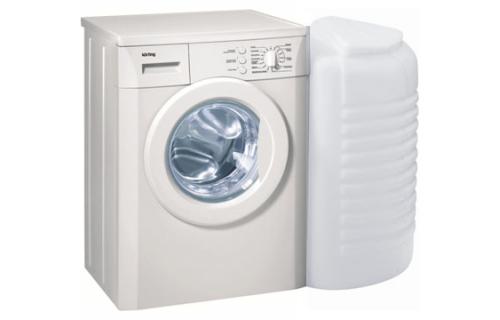
- Choose models with low energy consumption and water consumption. Firstly, they will help, save on electricity bills, and secondly, you will have to drag buckets of water less when filling the tank.
- Do not chase models with an enlarged water tank. This reservoir is wider than usual and takes up more space.
- Not all models of cars with tanks have a child lock, so if your family has children who are interested in household appliances, then choose models with a lock.
- If the quality of the water available for washing is unsatisfactory, then it is better to choose a model of the machine with a tank in which a special filter is installed that cleans the water.
If we analyze consumer reviews about the use of washing machines with a tank from the company Combustion, then we can generally come to the conclusion that the quality of such machines is quite satisfactory. From the point of view of some housewives, cars with a tank are too noisy, however, you need to understand that the manufacturer did not claim that his equipment would work silently.
Also, some complain about the inability to wash the water tank. Like, it has too narrow a neck, into which it is impossible even to climb with a hand. This opinion is subjective, although not devoid of rational grain. Real
Today she has become an irreplaceable assistant. It significantly shortens the washing time and simplifies the spinning process, especially when washing large items, such as blankets, car and furniture covers, bed linen... And if in a city apartment the installation of such an assistant does not raise any questions, then not everything is decided to buy a washing machine without connecting to running water to a country house or a village house. There are many controversial opinions and questions about this type of washer. Let's try to figure out: are there any machines that do not require connection to the water supply system, how to choose, connect and use such a washing machine and what difficulties may arise in this case.
Choosing a washing machine
According to the principle of operation, a washing machine without running water is not much different from a conventional washing machine installed in an apartment. Differences are only in the way of supply and drainage of water. It is worth considering that some manufacturers (for example, Gorenje) produce washing machines, taking into account the fact that they will be operated without being connected to the water supply system. They differ from conventional automatic machines by the presence of a plastic water tank with a capacity of 50-100 liters, installed on the side or rear. However, such a plastic tank can be bought without any problems and connected to any washing machine.
When choosing a machine that is planned not to be connected to the water supply, you should be guided by the same criteria as when choosing a conventional washing machine. While it is best to buy a machine with a smaller drum capacity whenever possible, consumers generally prefer to buy a larger capacity machine “in reserve”. This recommendation is based on the fact that the smaller the drum capacity, the less water the machine will use.
Organization of water intake and sewerage
How to connect a washing machine without running water? First of all, it is necessary to organize the intake and discharge of the water used for washing.
- Water intake organization methods:
- Adding water manually. Water is poured into the powder compartment. This method does not require any material and technical costs, but it is very time consuming and inconvenient, given that the machine will stop at every wash cycle and will not start it until the required amount of water is added.
- Water supply from the tank, standing next to with the car. In this case, it is necessary to create pressure so that water flows into the washing machine. You can create pressure using a blower (pump) installed between the tank and the machine or by installing a water tank 1-1.5 m higher than the machine, then the water will flow by gravity.
- Water comes from an underground well. This option is acceptable if there is a well equipped with a pump on the site. In this case, it is necessary to install additional filters in the well.
- Methods for organizing drainage:
- The easiest way is to connect a hose of sufficient length to the machine and lead it into a pre-dug hole on the site or a specially organized well.
- A stationary spillway consisting of a short hose and a plastic pipe leading to a pit. The advantage of this method: you do not need to carry water by hand and pull the hose. Minus: in winter, the pipe can freeze and burst, so it needs insulation.
- Draining into a prepared container. A method in which a machine drains water into a tank, which is emptied by hand filling. Minus: the tank takes up a lot of space and you have to take it out manually.
When planning the drain, remember that the washing machine drains soapy water that is not suitable for watering the garden. This water should be diverted as far as possible from the plants grown on the site to be eaten.
As you can see, a washing machine for a summer residence without running water is quite real, and with some investments (buying a pump, laying a drain pipe) it makes it possible to wash almost like in a city apartment.
Preparing to connect
Washing machines without a water supply take up a lot of space in the room due to additional equipment: a pump, water tanks.
The room where the machine will be installed must be heated. The floor on which the automatic machine will stand must be level to avoid vibration during operation. If the floor in the room is uneven, then you can use the props for the chipboard sheet and the building level for leveling.
Expedient without plumbing together with plastic water tanks or buy tanks separately. What else do you need to buy? First of all, you should buy a pump that will serve to pump water into the car, if, of course, you have chosen this particular method of supplying water. The pump can be small, people call such pumps "baby". Its cost is low, and its performance is quite enough to ensure an uninterrupted washing process.
Before starting work on the connection, you need to stock up on tools that you may need, as well as purchase some materials.
From tools you will need:
- adjustable wrench;
- pliers and pliers;
- tape measure and building level;
- set of screwdrivers;
- paper knife.
Completing:
- sealant, you can paste, but it is more convenient to use tape;
- plumbing and PVC pipes of the required length;
- filters and hose clamps;
- ferrules or tees;
- an extension cord for connecting to a power source (if the wire of the machine is short).
When purchasing a component, pay attention to the diameter of the purchased valves, clamps and couplings!
How to connect a machine without running water?
After installing the machine, we place the necessary containers. The water filling tank must be easily accessible for filling with water. In the bottom of the tank we make a hole with a diameter equal to the water intake hose, mount the adapter on the hose. We supply the hose from the reservoir to the pump. It is important to place the pump on a level surface to prevent vibration caused by water injection.
How to convert a washing machine to work without running water?
The automatic machine does not require any particularly complicated alterations. The only thing that needs to be done is to change the flow capacity of the valves. To do this, you need to remove the valves and remove the rubber seals from them. The valves are located at the junction of the water intake hose and the machine body. This manipulation is necessary if you do not use the pump, and water will flow into the machine by gravity. Thus, the automatic machine will not be able to adequately assess the pressure and will not be "confused" by prolonged filling with water.
<Далее подсоединяем шланг для забора воды к корпусу машинки-автомат и подключаем to the power supply. It is also necessary to synchronize the operation of the washing machine and the pump: when the machine needs water to start a certain cycle, power is supplied to the inlet valve, which immediately opens. At this time, the pump begins to pump water. After a sufficient amount of water has been collected, the machine stops the flow of electric current to the valve and it closes, and the pump turns off.
When connecting an automatic machine, it is important to remember: all contacts and connections must be insulated and sealed;
Checking the correct connection: commissioning
After connecting the machine, the machine without water supply must be checked for its performance. To do this, you need to connect the washing machine to the power supply and press the "turn on" button on its body. Turn the toggle switch for changing the wash modes (or press the buttons, depending on the model of the machine) and make sure that the machine responds to the change of modes. Because the washing machine has not yet collected water, then it is necessary to turn on the spin mode, the drum should begin to rotate. This allows you to evaluate the operation of the machine itself.
To assess the correctness of whether the washing machine was correctly connected to the pump and connected to the water intake tank without connecting to water, it is required to start the washing mode. During the first start, it is advisable to be near to control the operation of the pump and the washing machine itself. You also need to monitor for water leaks, if any, this means that you have not tightly connected the hoses and accessories. In this case, you will have to disconnect, seal and reconnect everything. When Mishina starts the spin cycle, pay attention to whether the vibration of her body has appeared. The appearance of vibration indicates that the machine is not level and must be leveled on the floor. Vibration should not occur during the operation of the injection pump.
Other options for organizing washing in the absence of running water
As mentioned, some manufacturers create washing machines that are originally designed so that they do not need a water connection. The downside of such automatic machines is their rare prevalence, which means that in the event of a breakdown, you are unlikely to be able to find a qualified repair technician who can fix the problem, and the cost is quite high.
The machines that do not need water supply include the Soviet activator-type washing machines - "Siberia", "Volga", "Assol", the compact model is "Baby". These machines only require power supply, and water is poured into them and then drained manually. Disadvantages of machines of this type: spinning has to be done manually, the washed laundry will have to be rinsed in a specially prepared container with clean water.
Do not forget about the existence of ultrasonic mini-washing machines of the "Retona" type. Of course, such machines are more suitable for washing a couple of things and will not be able to meet the needs of a family of several people. It is also impossible to wash large things with such mini-machines.
As you can see, the options to organize a more or less comfortable life even in the absence of water supply and sewerage are quite within our powers. It is not difficult to buy a washing machine without running water and connect it by creating an autonomous water intake system. As the saying goes: "there would be a desire ...".
New articles
- Moral problems of the novel "Eugene Onegin
- A story about the fate of Maria Mironova from "the captain's daughter"
- Analysis of the "black magic" scene in the novel "The Master and Margarita
- What does it mean to live for mtsyri
- Characteristics of the Kuragin family in the novel "War and Peace" by Leo Tolstoy Values \u200b\u200bof the Kuragin family
- The theme of love in the works of Kuprin and Bunin (School compositions)
- The dark kingdom in the play "Thunderstorm" - what is it?
- The history of the creation of the novel "Dubrovsky" by Pushkin The works of Dubrovsky are the most famous
- Bazarov and his relationship to art (based on the novel I
- Collisions of Pavel Petrovich with Bazarov
Popular articles
- Literary. Where do the plots come from. "The Secret of Charles Perrault". Preface to the translation of charles perrault's "fairy tales"
- The composition "Tales of Charles Perrault - artistic analysis
- Oblomov characterization of the image of Olga Ilyinskaya Sergeevna Olga Ilyinskaya's husband crossword clue 6 letters
- "Good is evil (" King Lear ")
- Russian education portal: Preschool education, primary school, study at gymnasium, lyceum, college, educational leisure, Distance learning - Russian education portal
- The philosophy of life of Platon Karataev
- Sage - Tolstoy A.N. Wise old man and stupid tsar Russian fairy tale about wise men and fools
- Analysis of the story "The Fate of a Man" (M
- The creative history of the creation of the novel "Crime and Punishment Dostoevsky Crime and Punishment Conception history of creation
- Inability to cope with myself
